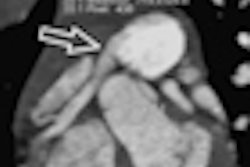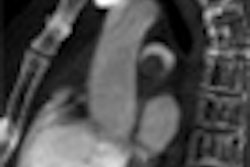As indicated by the increasing use of CT in pediatric patients worldwide, clinicians are not always following appropriate criteria when using the modality to scan these patients, according to a study in the May issue of the American Journal of Roentgenology.
Researchers from the International Atomic Energy Agency (IAEA) in Vienna surveyed CT use in 40 developing countries from 2007 to 2009 and found that guidelines were not followed in four of seven clinical situations.
Circumstances in which guidelines were not followed included cases of accidental head trauma, infants with congenital torticollis, children with possible ventriculo-peritoneal shunt malfunction, and patients younger than 5 years with acute sinusitis. Clinicians adhered to guidelines in cases of hydrocephalus, children with persistent headache, and those with an indication for appendicitis, such as acute abdominal pain.
Based on the overall results, lead study author Jenia Vassileva from the National Centre of Radiology and Radiation Protection in Sofia, Bulgaria, and study coordinator Madan Rehani, a radiation safety specialist with the IAEA, concluded there is a "strong need" to implement guidelines to avoid unnecessary CT examinations for children (AJR, May 2012, Vol. 198:5, pp. 1021-1031).
"We found that there was a lack of the use of appropriateness criteria, and we strongly feel that there is a need to strengthen utilization of appropriateness," Rehani told AuntMinnie.com. "We would recommend other modalities, such as MRI, in certain clinical applications to reduce the risk of radiation dose to pediatric patients."
Regional CT use
Geographically, the greatest frequency of pediatric CT exams was seen among Asian (12.2%) and African (7.8%) facilities that responded to the IAEA survey, while Europe had the lowest frequency of CT use (4.3%).
The IAEA, tasked with establishing and promoting the application of standards to protect people against the harmful effects of ionizing radiation, has established an International Action Plan on Radiological Protection of Patients.
The survey of 40 countries in Asia, Eastern and Central Europe, Africa, and Latin America included responses from 146 CT facilities at 126 hospitals. One part of the questionnaire asked about the number of CT examinations of the head, chest, and abdomen for adults and children during the two-year period. Specifically, respondents were asked about the number of CT exams performed, rather than the number of patients who underwent CT scans, to calculate a more accurate number of procedures and subsequent radiation exposure.
The poll also asked whether the radiologist or referring physician chose a CT exam for a pediatric patient, whether referral guidelines were used, and if previous images and patient dose records were available prior to the CT.
CT utilization
The total number of CT exams in facilities for adults and children combined increased 18.6% to 574,474 in 2009, compared with 484,500 in 2007. While there was a decrease in volume at some CT facilities, there was a 6.8% increase in pediatric CT scans, compared with a 19.8% gain in CT exams for adults during the same two years.
"Participating CT facilities in 15 of 29 countries showed an increase of more than 10% in the number of CT examinations of children from 2007 to 2009," the authors wrote, "whereas eight countries showed a decrease of more than 10%, and the remaining six had an increase or decrease of less than 10%."
Frequency of pediatric CT as a percent of total imaging exams
|
The head was the most frequently scanned part of the body (72%), followed by the chest and abdomen, which were scanned approximately 16% of the time.
As for who decides whether a pediatric patient receives a CT scan, 72 (56.7%) of the 127 respondents stated that it's a shared decision between the radiologist and the referring physician, while 47 radiologists (37%) said the referring physician made the call. Only eight radiologists (6.4%) made the decision themselves.
Based on 132 responses, 66 questionnaires (50%) indicated there are written referral guidelines available within the hospital, compared with 59 facilities (44.7%) that said there were no such guidelines. Seven facilities (5.3%) checked the "Don't know" answer option.
For 90 (69%) of 130 replies, respondents indicated that previous images and/or patient dose records are available and referred to prior to a pediatric CT scan, while 40 respondents (31%) said prior records were not referenced.
"Making conclusions about the national practice with this information is not possible, but in about one-third of situations, previous images and information on previously received patient doses were not available," the authors noted.
Modality of choice
Regarding the imaging modality of first choice, 55% of radiologists preferred ultrasound in pediatric cases of hydrocephalus, an abnormally large buildup of cerebrospinal fluid within the brain. CT was the modality preferred by 24% of the respondents, followed by 20% for MRI and 1% for x-ray.
If a child had a suspected case of appendicitis or acute abdominal pain, ultrasound was the first choice among 90% of radiologists who responded to the survey, with CT favored by only 1%. In cases of persistent headache, MRI was the first option for 48% of respondents, compared with 45% for CT. Radiography was at 4%, whereas ultrasound, at 2%, lagged behind.
For children younger than 5 years old with sinusitis, radiography was preferred by 72% of respondents, compared with 18% for CT.
Appropriateness criteria for the referral of CT exams for pediatric patients varied from country to country, and facilities "did not always follow guidelines set by the agencies," Vassileva and Rehani concluded. "Knowledge and use of these guidelines would improve clinical practice and lead to a reduction in the number of unnecessary CT examinations in children."



















